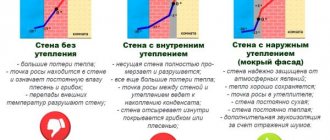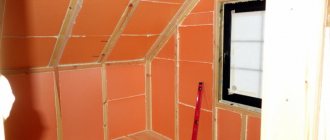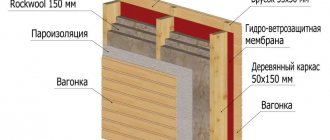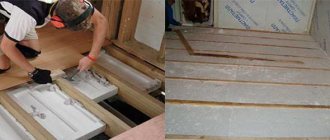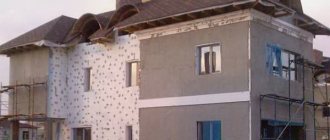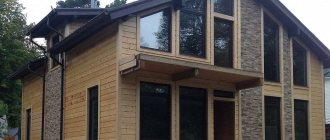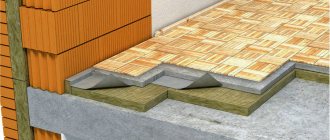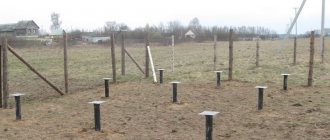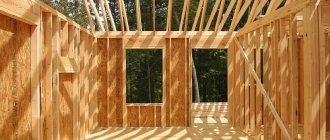Thermal insulation properties of clay
Many people know that clay was once used as the main building material for the construction of walls and ceilings.
The peculiarity of this material is that it hardens under certain conditions. It follows that clay can be soaked with water and used in construction, after which the material becomes almost monolithic. Today, clay is used to insulate ceilings. Naturally, the material of natural origin is also used for insulating walls, but the optimal effect is obtained only when insulating ceilings. In addition, builders recommend mixing the clay with sawdust before use, after which the insulation layer obtains excellent thermal insulation properties.
It is recommended to mix clay with sawdust for insulation
Don't think that sawdust doesn't matter in this case. And if you need to insulate the ceiling, you will still have to look for sawdust to add to the clay. Moreover, you don’t have to spend money on them - just visit some wood processing plant.
Protection of wool during installation
To prevent the basalt insulation from getting wet during installation, it is worth protecting the installation site from rain. For this purpose it is very convenient to use inventory scaffolding. And on these scaffoldings, lay boards along the upper rungs of the top row and stretch the film.
It will turn out cheap and cheerful. Not only the building materials will be dry, but also the installers themselves who work on the walls.
This is exactly how we put a “roof” on the scaffolding, so that the cotton wool does not get wet and the installers are dry.
To drain rainwater from film roofs on scaffolds, the easiest way is to use 3-4 drainage pipes with a diameter of 110 mm, into which the water accumulating on the film will be drained. This will allow you not to get wet under an unexpected “waterfall”, when water that does not have a drain bends the film and rushes down in an “unfortunate” place.
What properties should insulation for a frame house have?
Insulation materials used to insulate the walls of a frame house must have the following properties:
- low thermal conductivity;
- fire safety;
- low water absorption;
- no shrinkage;
- environmental friendliness.
Thermal conductivity
The ability of a material to transfer heat is reflected by its thermal conductivity coefficient. The lower its value, the less heat passes through the material. At the same time, in winter the room does not cool down so quickly, and in summer it heats up more slowly. This allows for savings on cooling and heating. For this reason, when choosing insulation, be sure to take into account the value of the thermal conductivity coefficient of the material when operating under specific conditions.
Water absorption
The next important indicator affecting the ability of insulation to retain heat is its water absorption. It represents the ratio of the amount of water absorbed by the insulation to the mass of the insulation itself. This characteristic demonstrates the ability, in the case of direct contact with water, to absorb and retain moisture in the pores.
Due to the fact that wet material conducts heat well, the lower this value is, the better. This is explained by the fact that when wet, the air pores of the insulation are filled with water, which has greater thermal conductivity than air. In addition, material that is too wet can simply freeze, turning into ice and completely lose its functions.
Fire safety
Fire safety of materials means the ability to withstand high temperatures without damaging the structure or igniting. This parameter is regulated by GOST 30244, GOST 30402 and SNiP 21-01-97, which divide them into flammability groups from G1 to G4, while completely non-flammable substances are designated NG. For frame residential buildings, insulation materials belonging to the NG group are most preferred.
Insulation shrinkage
When choosing a heat insulator for a frame building, you should definitely take into account such an indicator as shrinkage ability. This value must be minimal, otherwise during operation, material subsidence will appear in the places where the insulation is laid, which will lead to the formation of cold bridges and an increase in heat loss.
Environmental friendliness
The basis of the walls of a frame house is insulation. Since insulating material will surround you everywhere in a frame house, you need to be sure that it is really high-quality insulation and does not emit harmful substances.
Expanded polystyrene
Sheet materials - expanded polystyrene or polystyrene foam as insulation - are produced by extruding polyethylene and polystyrene.
Polystyrene foam is looser and is not used for screeds. Expanded polystyrene is dense and durable, it is successfully poured with concrete, its edges have a tongue-and-groove connection system. Polystyrene foam and expanded polystyrene are used for insulation of foundations, frame, concrete, and brick buildings. Advantages of sheet materials:
- Stoves saturated with carbon dioxide do not support combustion
- Ease
- Not afraid of moisture
The disadvantage is fusibility and the release of toxic fumes during melting.
Foam insulation - polyurethane foam
Modern insulation technology is spraying. A special machine dissolves the polymer and mixes it with air. Sprayed insulation is applied similarly to spray foam and is used for walls and roofs in cottages and frame houses.
Backfill materials
The materials are not afraid of moisture and organic matter.
They are poured dry into cavities - grooves, floor and ceiling joists. Wet method - mixed with concrete. Expanded clay is an artificial stone made from baked clay.
Vermiculite is a natural stone that can absorb odors. It is poured into geotextile bags, which are placed in place.
Styrofoam balls - mixed with mortar, make screeding easier, added to concrete blocks.
Another type of backfill material is sawdust as insulation. This material is one of the most affordable in financial terms, while sawdust has a high degree of thermal insulation. Sawdust can be used to insulate floors, walls, and ceilings.
Don't want to deal with sawdust and other bulk materials? Then we recommend that you read the information about polyurethane foam insulation in this article. This material can be used to insulate a house without involving outside help.
Foam glass
This new product on the construction market is durable, environmentally friendly, not afraid of moisture, and has a relatively large weight and cost.
It is used in the form of granules (a competitor to expanded clay), blocks and sheet material. Foam glass is used when the characteristics of other insulating materials do not satisfy the purpose of construction. Suitable insulation is selected based on the characteristics of the object, cost, stage of construction and area of application.
Formation of the rough layer
Sawdust provides reliability to the plaster mortar. If they are not available, in order to apply the rough composition to the gypsum surface, you will need to attach a reinforcing nylon mesh. It is better to fix it directly with a solution; when used to secure nails, the integrity of the wall is compromised and the strength deteriorates. It is practical to treat clay walls with plaster with an assistant who will point out places that need improvement. The process includes the following steps:
- To work, you will need a grater board or spatula.
- Two or three mounds of plaster are applied to the working tool.
- The tool with the solution is pressed tightly and distributed over the surface.
- The direction of movement is from bottom to top. You should try to distribute the plaster as evenly as possible.
- The flat surface of the wall is checked using a building level. Identified irregularities are eliminated immediately after detection.
If the wall is relatively flat, a starting layer of 1 cm is sufficient. If there are significant unevenness on the clay surface, the plaster layer can increase to 3-5 cm.
Advice! When processing large areas of clay walls with your own hands, it is much more convenient to apply plaster using beacons. This will speed up the entire work process and increase the quality of the finish.
After applying the rough layer of plaster solution, time is required for it to dry completely. The entire process takes on average 4-6 weeks. The approximate drying period for a 1 cm thick layer at room temperature is 5 days, and it is not recommended to speed up the process using a technical hair dryer or heaters. Therefore, it is better to plan the work for the warm period. It is optimal when the initial finishing begins in late spring - early summer, although it all depends on the region where the house with clay walls is located. Professional steps for applying plaster to walls can be seen in the following video:
Technology
Those who prefer to insulate a house with their own hands should first read the instructions and learn how to properly glue mineral wool to a wooden or brick wall or aerated concrete base.
First of all, you need to prepare the surface of the external walls. They must be cleaned of dirt and dust, and all irregularities must be eliminated. If there is old paint or plaster, it can be removed using a spatula or solvent.
Preparing and laying insulation
Let's start preparing the surface of the mineral wool. To do this, you can use special adhesive compositions, for example, glue such as Ceresit CT 180. This composition must be applied to prepared mineral wool slabs using a special spatula. The glue layer should be no more than 0.5 centimeters. In order for it to adhere better, one or two layers of primer must be applied to the mineral wool.
When the wool slabs are prepared, they need to be carefully glued to the facade. In those places where the wool joins the window, you need to make sure that the joint of the insulation does not border on the edge of the window opening. Otherwise, heat leakage may occur. You also need to make sure that the mineral wool tightly covers the space between the beams.
When the mineral wool is well glued, it is worth doing additional fixation. This is required in order to increase the safety of the entire structure, because the weight of a cotton block is twice that of foam blocks. Dowels can be used as additional fastening. However, additional work can be carried out only after a day, when the glue has completely dried.
For one block of mineral wool you will need to use 8 fasteners. To do this, you need to make holes in the wool blocks, the depth of which will be several centimeters greater than the length of the dowel itself.
Next, you need to start installing “patches” in the corners where the openings and walls meet. In this way, the entire façade structure is strengthened. Lightweight “patches” are made from pieces of reinforced mesh. At the very beginning, a layer of glue is applied to the desired places. After this, a reinforcing mesh is installed on these areas.
When all the “patches” are ready, you can begin installing the reinforcing mesh. To do this, you also need to apply an adhesive composition, on which the mesh is fixed. If insulation is done under siding, then only a layer of mineral wool will be sufficient - laying reinforcing mesh will not be required in this case.
Waterproofing
To protect the room from moisture penetration from the inside of the house, a layer of vapor barrier must be laid under the mineral wool. To do this, it is best to use a diffuse membrane that allows air to pass through perfectly. It should be mounted directly on the wall using a regular construction stapler.
It is also possible to attach individual membrane strips. To fix them, it is best to use brackets. All seams must be well insulated with adhesive tape.
To summarize, we can say that insulating the walls of a house with mineral wool will help cope with such a problem as heat loss.
For tips on insulating with mineral wool, see the following video.
Preparation of clay-based insulating mass
This process is the most responsible. As we mentioned earlier, any imbalance in proportions can be a serious problem.
- First of all, we need an iron barrel in which our future insulation will be mixed. You need to place a certain amount of clay in this container. In this particular case, we will use about 5 buckets of natural material.
- The clay is poured on top with a small amount of water. After this, you need to leave the mass for some time to soak.
- Immediately stir the mixture. This is done until the consistency of the clay becomes like sour cream.
- Next we need a concrete mixer. We put about half of the mixture obtained earlier there. At the same time, sawdust should also be placed in the concrete mixer. As for the proportions, here for 1 bucket of clay there are 2/3 of a bucket of dense sawdust. In this case, the proportions may change slightly. Ultimately we should get a dense mixture. Accordingly, if you end up with something very liquid, you should feel free to add more clay.
What to choose
All the described materials have their advantages and disadvantages, however, when choosing, it is also necessary to take into account the characteristics of the insulated room. Complexity of installation, availability of appropriate qualified workers. Under no circumstances should you violate the technology for laying this or that material, as this can lead to a lack of heat in your home, and identifying and eliminating such defects may require much greater resources.
If your choice is between basalt blocks and ecowool, take into account the availability of qualified installers with special equipment; if you don’t find them, it’s better to use a simpler material - basalt blocks.
The best manufacturers
According to builders and customer reviews, the most reliable brands are:
- Isover is a subsidiary of the French construction concern Saint-Gobain. Izover is the only manufacturer in the Russian Federation that simultaneously produces two types of mineral wool - basalt and quartz. The company’s catalog also includes sound and heat insulation solutions made from glass and mineral fibers, expanded polystyrene (for walls, roofs, pipelines, etc.)
- Knauf is a German manufacturer of construction equipment and materials.
- Rockwool is an international group of companies headquartered in Denmark. The Rockwool division is engaged in the development and production of stone wool for heat and sound insulation, as well as fire protection of all types of buildings, ships, and equipment. The materials are made from gabbro-basalt rocks.
- URSA is one of the most famous Spanish companies producing heat and sound insulation materials. The company's name has become a household name in construction. URSA products have been represented on the Russian construction market for more than 20 years. The products meet international quality standards, are safe, environmentally friendly, and durable.
- Penoplex is a Russian manufacturer that produces polymer materials for hydro- and thermal insulation, decorative and finishing works.
- TechnoNIKOL is a Russian manufacturer of thermal and waterproofing insulators, as well as roofing materials.
- ShelterEcoStroy is a Russian manufacturer of environmental insulation materials. The products are distinguished by high heat and sound insulation qualities. The company's product range includes solutions for wind protection and insulation of frame houses, thermal insulation of walls, basements and basements, roofs, as well as technological equipment.
Ecowool insulation
Insulating a frame house with ecowool is an effective thermal insulation that has recently become very popular among owners of private buildings. Cellulose insulation provides complete protection of the structure from rotting, fungal and moldy microorganisms, and rodents. In addition, ecowool belongs to the category of materials characterized by excellent sound-absorbing and heat-insulating properties.
Natural heat insulator is ideal for arranging load-bearing walls. Frame buildings are not always simple in design. There may be various braces, protrusions, and spacers, which greatly complicate the installation of insulation. For example, laying polystyrene foam on walls of complex configuration means doing the work in vain. There will be gaps, cold bridges, and the material is unlikely to hold up well.
Ecowool, in turn, provides a seamless fabric and completely fills all cracks and crevices. The simplest thermal insulation of frame walls is done between the studs. To do this, a special windproof material is installed on the outside, which can be waterproof slabs. The second option for thermal insulation is installation of boards at an angle.
There are two methods of applying ecowool - the dry version and the wet-glue method. In the first case, the frame is covered from the inside with kraft paper, which is reinforced with construction foam for reliability. Next, a hole is made in the canvas into which a hose is inserted and the ecowool is blown in. During the installation process, it is necessary to constantly monitor the blowing density, otherwise the material may shrink.
The same insulation can also be used to insulate internal wall partitions. The only difference is in the thickness of the applied layer. To perform the work, the second method above is used - wet-glue. Installation of ecowool buildings in most cases is carried out by a team of professional workers. They guarantee high-quality and fast insulation.
Working with foam plastic
The main material for frame-panel country houses is wood. Such a building initially has insufficient insulation; its design is designed for comfortable living in warm weather; for year-round living, the house must be insulated. At the same time, there are requirements for insulation, and thermal insulation technology has been developed.
The material must have low thermal conductivity and be durable. Installation should be simple, not require special knowledge, labor-intensive costs, or expensive equipment. Therefore, foam insulation is often chosen as the best option.
The main advantages of polystyrene foam are its versatility, excellent thermal conductivity, good resistance to mechanical loads, and minimal density. You can select the thickness of the walls yourself. Work and materials are cheaper than using glass wool or mineral wool. Polyfoam resists moisture well; there is no need for vapor barrier or waterproof films.
Polystyrene foam is a lightweight material, it is easy to cut and adjust the size of slabs for insulating the foundation, roof, and basement of a building. The loads on the walls and foundation are minimal. At the same time, 12 cm of polystyrene foam can replace 2 m of brick wall and 4 m of concrete in terms of thermal conductivity.
Thermal insulation of walls with foam plastic boards should be carried out correctly at above-zero temperatures.
The only drawback is increased fire safety requirements; foam plastic is not resistant to fire. Therefore, before insulating a frame wooden house, additional protection is carried out - fire protection treatment of frame walls.
Fire protection treatment of walls is needed to prevent fire of foam plastic.
How to prepare the solution?
Clay with sawdust works well as wall insulation only if the materials are selected, prepared and applied correctly. The process of insulating a house begins with preparing a solution and selecting materials. Both components of the mixture can be obtained for free
But you should pay attention to their quality
Clay
The material is available, inexpensive, and in some cases can be obtained for free.
You should pay attention to the quality of the material: the presence of foreign objects in the material is not allowed
You can use clay that you just brought, but to obtain the ideal consistency of the mixture and the durability of the insulation, you need to prepare the clay. To do this, fill it with water, mix it and leave it for the winter. During this time, the material goes through several cycles of thawing and freezing. Natural heaving forces the material to expand and contract again several times, the clay becomes homogeneous and plastic.
Clay can be “skinny” or “fat”; plasticity depends on the fat content. When using “oily” (plastic) clay, it is necessary to add a little sand to the insulation composition.
Clay for preparing the solution
Before starting work, the clay must be prepared: left for the winter in a water-saturated state.
Sawdust
Sawdust is a waste product from the wood processing industry. They can be specially purchased at a low price at any enterprise. To insulate walls, you can use different sawdust, which have their own beneficial properties:
- Oak almost does not change its size and density under the influence of moisture, almost does not rot, and is resistant to bacteria.
- Coniferous sawdust is less susceptible to mold formation than other types of wood due to its high content of essential oils.
When insulating walls, you can use a mixture of several types of sawdust.
Before starting work, sawdust must be prepared:
- First, the sawdust is removed from impurities, sifted and washed.
- After this, the sawdust is thoroughly dried.
- Dry sawdust must be impregnated with compounds that protect the wood from rot, mold and fire.
Sawdust for preparing the mixture
You can use mixed sawdust to obtain better properties of the thermal insulation material.
Preparation of the solution
To properly prepare the mixture, you need a set of tools:
First, the clay is soaked in one of the barrels. Leave it for several hours and stir occasionally until it becomes homogeneous. After this, 1–2 buckets of clay are poured into a concrete mixer and sawdust is gradually added there in a ratio of 3:2, respectively.
To achieve better thermal insulation properties, technical salt is added to the mixture, but in this case the proportion of clay and sawdust changes to 1:1.
After a short stay in the concrete mixer, the mixture is ready for use; it is poured into a second barrel or installation begins immediately.
Application
To apply insulation to the walls, you can use formwork, but this method is very labor-intensive; it is much easier to prepare slabs from insulation:
- To make slabs, you need to make several molds for them in advance. Their size will depend on the parameters of the wall. You can prepare the forms yourself by assembling them from plywood and blocks using nails and a hammer. The thickness of the insulation boards will depend on the average winter temperature and the presence of technical salt in the mixture.
- The mold is filled with the prepared solution in small portions and periodically leveled. It is advisable to minimize the number of air bubbles and thicken the mixture.
- The installation of the slabs is carried out after the material has hardened; you can use slabs that are not completely dried, it is enough that they simply hold their shape.
- The plates are installed close to each other and secured.
- The joints, chipped corners and gaps are covered with the remains of the clay mixture.
Installation of clay slabs with sawdust
For installation, wooden guides are used, slabs are placed between them and then the joints are rubbed with the remainder of the clay mixture.
This technology for home insulation ensures cleanliness in the room during installation. Raw clay is a very dirty material that is difficult to clean. It is not recommended to use it in rooms where installation work has already been completed. The slabs can be prepared in another place, keeping the room clean.
It is very important to dry insulation boards correctly. When drying quickly, a dense dry crust forms on the surface of the slabs, preventing the water inside from escaping, which leads to uneven drying, damage and loss of thermal insulation properties.
To dry the slabs evenly, they must be left in a room with sufficient humidity and protected from direct sunlight.
DIY sawdust insulation
Thermal insulation of a house using wood waste takes a lot of time. The solution is prepared gradually, as it hardens quickly. Especially if the solution consists of sawdust, gypsum, lime. But most often they take:
- lime;
- shavings or sawdust;
- water;
- antiseptic;
- cement.
Before making sawdust insulation with your own hands, you need to know the correct ratio of components. The proportion should be: 10 buckets of wood waste + 1 part each of cement and lime. The required amount of “ingredients” is placed in the container, after which they need to be mixed until the mass becomes homogeneous. The antiseptic is dissolved in water according to the instructions. Next, the sawdust mixture is poured into the solution using a watering can.
To check whether the solution has been prepared correctly, you should take a little sawdust in your hands and squeeze it slightly. The lump should not fall apart, and no water should be released from the mixture.
Next, the solution is poured and compacted. It is worth considering that the room must be constantly ventilated during all work and subsequent setting of the mixture. After two weeks, the backfill site is checked for voids. They should be filled again with sawdust solution.
How to choose the right sawdust
Not all wood waste is equally suitable for thermal insulation of buildings
When choosing shavings and sawdust, you should pay attention to the following parameters:
- sawdust storage time. In this case, the rule applies - the less, the better. Otherwise, the risk of purchasing material affected by fungi and mold will increase significantly. The shavings should rest for at least 2-3 weeks;
- sawdust moisture. If the binding component will not be used, then a value of up to 14% is optimal. During the work, binders will be added, which means that the indicator should be no more than 20%;
- wood species From deciduous trees you need to choose birch, acacia or oak. Sawdust from coniferous trees is the best raw material. If wood waste contains bark, it is better to discard it. They may contain insect larvae.
It is better to purchase waste from wood processing of the middle fraction. If the sawdust is dust, it will be more difficult to work with such raw materials. The use of large chips increases heat loss rates.
What to consider when insulating with sawdust
Before you begin directly to work on insulating your house, it is worth considering that the shrinkage of sawdust is very large. Therefore, when carrying out thermal insulation work, you should adhere to the following tips:
- It is necessary to compact the sawdust mixture. Within 1-2 weeks, you need to inspect the insulated areas for the formation of voids. They should be filled with solution.
- To prevent heat loss, you need to top up the insulation layer from time to time, since the insulation will sag throughout its operation.
- The use of antiseptics cannot be ignored. Otherwise, the service life of the thermal insulation will be much shorter.
- Work is carried out exclusively in the summer season, as the temperature must be at least +15 °C.
Sawdust itself takes a long time to dry, and adding impregnation increases this period. The drying process itself is carried out indoors, where natural ventilation takes place. It will take a whole season to dry the insulation material. The insulation process itself is carried out only next year. You can speed up the process if you add impregnation directly to the water during the preparation of the solution.
In general, wood waste is still in demand for use as insulation. It is beneficial to use them to save money, as well as to create a favorable climate in a residential building. But the work itself is labor-intensive. Sawdust must be selected correctly, pre-processed and dried, a solution must be prepared from it, blocks and briquettes must be made. It takes a lot of time, but if you approach the insulation process correctly, the structure will be warm and durable.
Sawdust as insulation: pros and cons
First of all, let's look at why sawdust is used to insulate a wooden house.
The main advantages of sawdust are their low price and excellent thermal insulation properties. In addition, this is a completely natural material, which cannot be said about more modern thermal insulators. This is important for allergy sufferers and families with children, as well as for people trying to minimize the presence of chemicals in the home.
After all, any modern materials release the substances they contain, and this can affect the health of the residents of the house.
Disadvantages include easy combustion and the fact that untreated sawdust can harbor rodents. These issues can be circumvented by treating sawdust with antiseptics - a solution of copper sulfate or boric acid. In addition, to improve properties, sawdust is mixed with other materials (clay, lime, cement, gypsum). The disadvantages of working with sawdust also include the rather labor-intensive technology of their use.
Compromise, but reality
Universal insulation is always a compromise, because each structural element of the house has its own specific requirements for thermal insulation. But now there are already materials obtained by thermal bonding (polyester insulation), which are at the same time environmentally friendly, resistant to moisture, heat-efficient, unattractive to all types of pests and, with such an extensive list of useful properties, have a very reasonable cost.
On FORUMHOUSE you can read an article that examines in detail the pros and cons of natural insulation and find out what consequences improper vapor barrier leads to. We choose insulation for thermal insulation of the interfloor ceiling in a wooden house. Join the discussion on how to choose insulation for different elements of the house. Watch a video about the insulation system invented by a member of our portal.
Subscribe to our Telegram channelExclusive posts every week
A little physics
Before delving into the technological aspects of using the product, let’s look at its physical and technical characteristics. And they are not too happy. Thus, the density of hardened clay is 1600-2400 kg/m3 (slightly less than that of concrete), and the thermal conductivity is 0.7-0.9 W/m°C.
It turns out that clay as a wall insulation is, to put it mildly, useless, so why is it still used?
The fact is that this material is an excellent binder, the strength of which is not affected in any way by the sucrose found in organic fillers (it is destructive for concrete), and this, in turn, opens up the widest scope for maneuver.
Material selection
According to their composition, all insulation materials are divided into:
- bulk;
- woody;
- foam;
- mineral wool (for example,).
- blocks;
- slabs;
- rolls;
- mixtures.
And according to their appearance, these materials can be divided into the following:
- blocks;
- slabs;
- rolls;
- mixtures.
When choosing a thermal insulation material, you need to pay attention to its specific properties. The fact is that there are now many manufacturers of materials for building insulation on the market, and even seemingly identical mats or slabs can have different indicators. Let's look at the most basic of them:
Let's look at the most basic of them:
- thermal conductivity coefficient, the lower it is, the thinner the layer of insulation you can get by with;
- moisture absorption coefficient, the lowest is required;
- fire resistance depends on the ignition temperature, the higher it is, the less flammable it is and the more suitable it is for you;
- durability, it is clear that we choose the one with a longer service life;
- environmentally friendly, mandatory for indoor use, insulation must comply with safety standards for human health.
Only after studying what properties the material you like has, and comparing it with others, will you be able to decide how to insulate your country house.
And according to their appearance, these materials can be divided into the following:
- blocks;
- slabs;
- rolls;
- mixtures.
When choosing a thermal insulation material, you need to pay attention to its specific properties. The fact is that there are now many manufacturers of materials for building insulation on the market, and even seemingly identical mats or slabs can have different indicators. Let's look at the most basic of them:
Let's look at the most basic of them:
- thermal conductivity coefficient, the lower it is, the thinner the layer of insulation you can get by with;
- moisture absorption coefficient, the lowest is required;
- fire resistance depends on the ignition temperature, the higher it is, the less flammable it is and the more suitable it is for you;
- durability, it is clear that we choose the one with a longer service life;
- environmentally friendly, mandatory for indoor use, insulation must comply with safety standards for human health.
Only after studying what properties the material you like has, and comparing it with others, will you be able to decide how to insulate your country house.
Rockwool insulation - technology guarding comfort" href=»https://pro-uteplenie.ru/neorganicheskie/minvata/53-uteplitel-rockwool">Rockwool insulation).
And according to their appearance, these materials can be divided into the following:
- blocks;
- slabs;
- rolls;
- mixtures.
When choosing a thermal insulation material, you need to pay attention to its specific properties. The fact is that there are now many manufacturers of materials for building insulation on the market, and even seemingly identical mats or slabs can have different indicators. Let's look at the most basic of them:
Let's look at the most basic of them:
- thermal conductivity coefficient, the lower it is, the thinner the layer of insulation you can get by with;
- moisture absorption coefficient, the lowest is required;
- fire resistance depends on the ignition temperature, the higher it is, the less flammable it is and the more suitable it is for you;
- durability, it is clear that we choose the one with a longer service life;
- environmentally friendly, mandatory for indoor use, insulation must comply with safety standards for human health.
Only after studying what properties the material you like has, and comparing it with others, will you be able to decide how to insulate your country house.
Thermal insulation requirements
There are no capital walls as such in frame structures. All heat-protective functions are performed by multi-layer enclosing structures.
When choosing a thermal insulation material, the basic requirements for insulation for wooden buildings are taken into account:
- environmental Safety;
- fire resistance;
- low thermal conductivity;
- moisture resistance;
- durability.
Products with irregular geometry or damaged corners are not allowed. Do not use materials that have expired. Mineral wool slabs, which have a tendency to caking and high water absorption, are especially sensitive to storage conditions.

